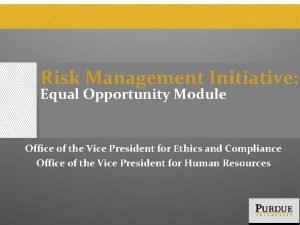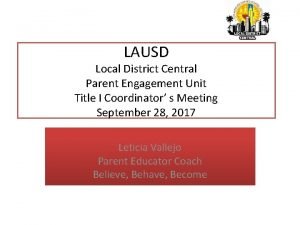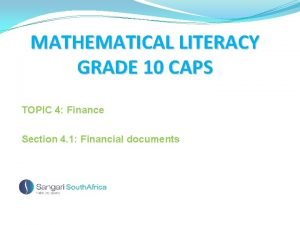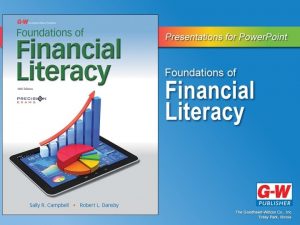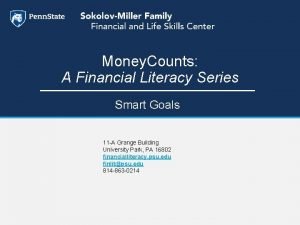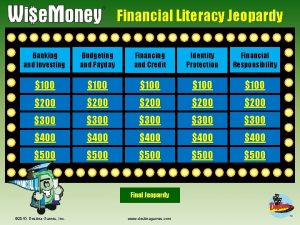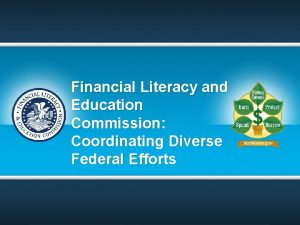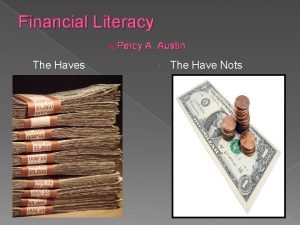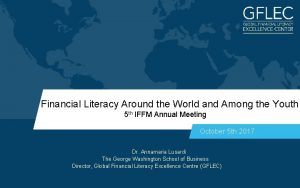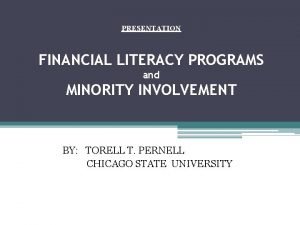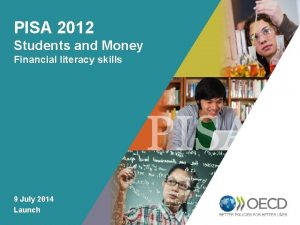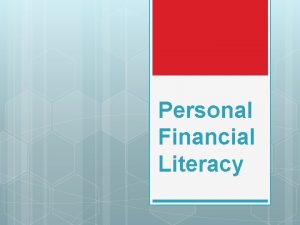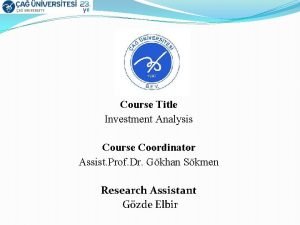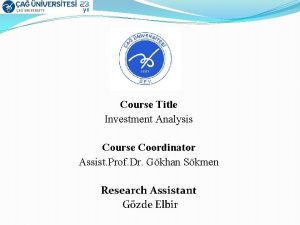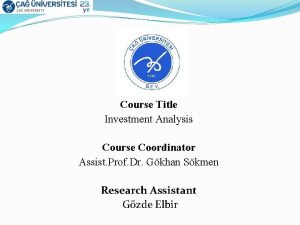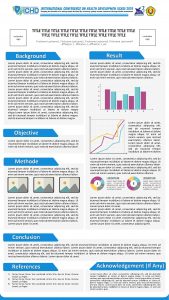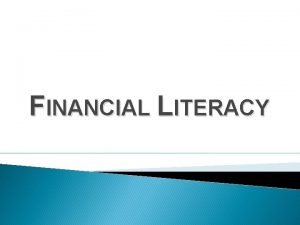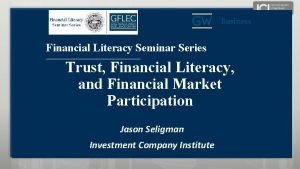Course Title Financial Literacy Course Coordinator Assist Prof





















- Slides: 21

Course Title Financial Literacy Course Coordinator Assist. Prof. Dr. Gökhan Sökmen Research Assistant Gözde Elbir

Learning Objectives After studying this chapter; �You will be able to analyze the process for making personal financial decisions. �You will be able to identify personal financial process. �You will be able to explain types of budgeting systems �You will be able to create and implement a budget. �You will be able to create personal budget via excel.

Personal Financial Planning �Personal financial planning is the process of managing your money to achieve personal economic satisfaction. �This planning process allows you to control your financial situation. �Since every person, family or household has a unique financial position, every financial activity must be carefully planned to meet specific needs and goals.

The Financial Planning Process �The advantages of personal financial planning include: v Increased effectiveness in obtaining, using and protecting your financial resources throughout your life. v Increased control of your financial activities by avoiding excessive debt v Improved personal relationships resulting from well-planed and effectively communicated financial decisions. v Enhanced freedom from financial worries.

The Financial Planning Process �We all make hunderds of decisions each day. Many of these choices are quite simple. However, some are complex and have long-term effects on our personal and financial situations. �Personal financial activities involve three main decisions areas:

The Financial Planning Process � While everyone makes decisions, few people consider how to make better decisions. The financial planning process is a logical, six-step procedure that can be adapted to any life situation.

The Financial Planning Process �Step 1: Determine your current financial situation: First, determine your current financial situation regarding income, savings, living expenses and debts. �Step 2: Develop financial goals: How will economic conditions affect your goals and priorities? The purpose of this analysis is to differentiate your needs from your wants. �Step 3: Identify alternative courses of action: Creative decision -making is vital for effective choices. For instance, most people believe they must own a car to get to work or school. However, they should consider other alternatives such as public transportation, capooling, renting a car, shared-car ownership or use a ride-sharing program.

The Financial Planning Process �Step 4: Evaluate your alternatives: Evaluate possible courses of action, taking into consideration your life situation, personal values and current economic conditions. �Step 5: Create and implement your financial action plan: This step involves developing an action plan to identify methods to achieve your goals. �Step 6: Review and revise your plan: You need to regularly assess your financial decisions.

BUDGETING Create and implement a budget. � A budget is a spending plan � The main purposes of a budget are to help you: � Live within your income � Spend your money wisely � Reach your financial goals � Prepare for financial emergencies � Develop wise financial management habits

Creating and Implementing a Budget

The Budgeting Process �Step 1: Set Financial Goals �Step 2: Estimate Income �Step 3: Budget An Emergency Fund and Savings �Step 4: Budget Fixed Expenses �Step 5: Budget Variable Expenses �Step 6: Record Spending Amounts �Step 7: Review Spending and Saving Patterns �Review Your Financial Progress �Revise Your Goals and Budget Allocations

The Budgeting Process Determine Income Calculate your income. Identify all income sources: • Wages/salaries • Gifts or allowance • Interest • Scholarships, grants, and student aid Determining Your Expenses Expense Considerations • Consider all examples • Determine which are fixed and which are variable expenses • Know what you owe. • Consider your ongoing needs. • Plan other expenditures. • Identify how much money you need to cover expenses. • Expect the unexpected.

Characteristics of Successful Budgeting �A budget will work only if you follow it. �Experts advise that a successful budget should be: � Well planned � Realistic � Flexible � Clearly communicated

Types of Budgeting Systems Mental budget: • exists only in your head Physical budget: • use envelopes for your expenses such as food, rent, etc. Written budget: • detailed plan for spending in a spreadsheet or notebook Computerized budgeting system: • use Excel or software such as Quicken Online budget: • use bank or financial institution website Budgeting app: • use cell phone or tablet

Realistic Budget Building Budget: Itemized summary of estimated income and expected expenditures during a given period �Observe spending habits via a spending journal. �Record your income and when you receive it. �List all your fixed expenses and when they are due. Be careful with fixed expenses.

Realistic Budget Building � List your variable monthly expenses. Variable expenses can be controlled and changed. �After 1 month, project spending and earnings for the next 12 months. �Project when extraordinary expenses and income will change to maintain a positive cash flow. This is where the Emergency Fund comes into play.

Example: Annual Personal Cash Budget � Annual Personal Cash Budget showing monthly inflows and outflows.

�https: //www. viddler. com/embed/23371889/? f=1& player=arpeggio&secret=37455950&make_respons ive=0

Create a Budget How much money do you get each month? Income $2, 000 Income What expenses do you have each month? Fixed Expenses Rent Cell Phone Car insurance ($300/quarter) $ 100 $ 600 $ 40 Variable Expenses Food (estimate) Utility bills (estimate) Gas $ 500 $ 50 Total Expenses $1, 540 Fixed Expenses Variable Expenses

Create a Budget �Excel practice

Questions 1) What are the advantages of personal financial planning? 2) What are the main decisions areas in personal financial activities? 3) Explain the steps of the financial planning process. 4) What is a budget and what are the main purposes of a budget? 5) When making a budget, which items do you need?
 West lafayette campus title ix coordinator
West lafayette campus title ix coordinator Lausd central district
Lausd central district Course number and title
Course number and title Multi-cultural literacy
Multi-cultural literacy Media in mil
Media in mil People media definition
People media definition Cyber literacy for the digital age
Cyber literacy for the digital age Bhartiya model of financial literacy
Bhartiya model of financial literacy What is tariff in maths
What is tariff in maths What does the star on a till slip mean
What does the star on a till slip mean Financial literacy grade 4
Financial literacy grade 4 Chapter 1 financial literacy basics
Chapter 1 financial literacy basics Smart goals financial literacy
Smart goals financial literacy Financial literacy jeopardy
Financial literacy jeopardy Financial literacy and education commission
Financial literacy and education commission Pshe financial literacy
Pshe financial literacy Next generation personal finance standards
Next generation personal finance standards Financial literacy austin
Financial literacy austin Financial literacy around the world
Financial literacy around the world Needs vs wants financial literacy
Needs vs wants financial literacy Financial literacy at minority serving institutions
Financial literacy at minority serving institutions Pisa financial literacy
Pisa financial literacy
